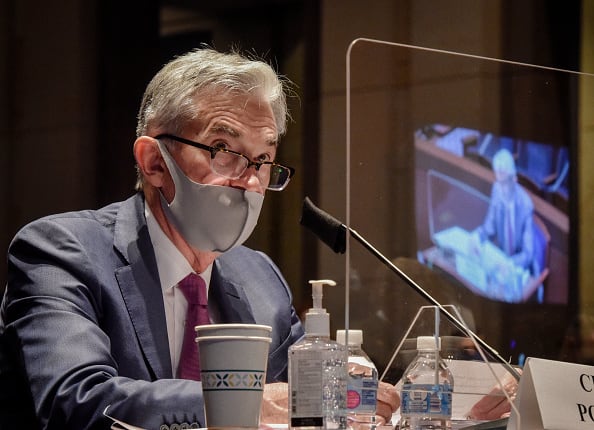Fed Chairman Jerome Powell is reflected in the sneeze guard set up between himself and members of the House Committee on Financial Services hearing on Oversight of the Treasury Department and Fed Reserve Pandemic response on June 30, 2020 in Washington, DC.
Bill O’Leary-Pool | Getty Images
Government spending from the Treasury Department and Congress along with stimulative bond purchases from the Federal Reserve are at unprecedented levels.
Deficit spending for the U.S. is over $3 trillion so far this year. While the costs are clear, the benefits are less so. Financial relief for millions of Americans furloughed or unemployed has been a humanitarian godsend.
Some argue that it was too much, and it may have been for some, but at moments of crisis, moments of necessity, more is better than not enough. The relief provided by the initial $1,200 checks and the ongoing supplemental unemployment insurance was the difference between being able to endure lockdown and going hungry for many of our fellow Americans.
Yet, as the government spends, debt is accumulating. The Federal Reserve’s balance sheet has increased by about $3 trillion this year, and the Fed is encouraging Congress to provide greater stimulus. Many are beginning to ask if more stimulus is the correct response, or is it merely pushing on an economic rope?
After the banking crisis of 2008 and 2009, the Fed began to increase its balance sheet by purchasing Treasury bonds as a means of providing liquidity to the banking system and to keep interest rates low. Much of this spending is known as Quantitative Easing. And it worked — sort of. For all the spending, economic disaster was successfully averted, but GDP growth never got much better than about 2% per year.
In February, unemployment was about 3.5% and wages were beginning to rise. We may have been at the genesis of an organic renaissance of demand and growth. Alas, we will never know as the effects of a pandemic threw the U.S. and most of the world into recession with unemployment spiking to over 15%. The response to this great recession that may indeed be a depression, is a remarkable increase in the deployment of stimulus.
Time for a different approach?
The Fed is now encouraging additional government spending to stave off a deeper recession. Congress and the White House are bickering over this spending package and don’t seem to be getting anywhere. Will more spending lead to economic growth, or is it time for a different approach?
Monetary and fiscal spending have not generated significant growth over the past decade. Our current efforts continue to make the same mistakes. There are two primary mistakes: one, while surges of liquidity can stave off economic collapse, and provide needed relief, they have little ability to stimulate sustained growth. When growth doesn’t come, policy makers add more stimulus. Two, cheap money has increased supply and done little to increase demand.
We can increase the production of donuts, but we can’t increase the number of willing and able donut buyers.
I have three conclusions: Milton Friedman’s notion that inflation is always and everywhere a monetary phenomenon is incorrect unless the monetary stimulus generates demand. Without increased demand, there is no inflation. Second, the funding over the past ten years of QE hasn’t created any multiplier effect. A trillion dollar injection results in a one-time trillion dollar surge and another trillion in debt because the U.S. doesn’t have an extra trillion lying around somewhere. The 1990s were the last time the U.S. ran a surplus.
Third, it would have been better if the trillion dollars were spent on something that would grow and create jobs and increase over time. This would be the sort of investment that private industry or individuals would make. Think about spending a trillion dollars to take every American to an amusement park. Spirits would be lifted, and folks would have fun, but they’d leave and return to the same old, same old, and you’d be out a trillion in cash. (Though to be sure, the amusement parks would LOVE you.)
What if we were to spend your trillion to provide job training in computer coding, artificial intelligence jobs, renewable energy jobs and jobs rebuilding infrastructure? That trillion dollars would create a generation of producers and earners and creative innovators and problem solvers that would better the future for generations to come.
That trillion dollars could produce returns for many years that would also result in higher tax revenues. The devastating part of all this heretofore one-buck-for-one-bang aid, is that it keeps heaping on the national debt, without sparking the ongoing economic prosperity to pay for the debt. This is a shameful legacy and inheritance for our grandchildren.
Stimulus needs to, well, stimulate. We have an opportunity, and a common shared national interest in building a better economy out of the ruins in which we find ourselves. The argument shouldn’t be over more money or less money — but is the money an investment in the long term health of the country that will, in societal and civic terms, as well as purely economic terms, create a tomorrow that will be better than yesterday?
In the end, the Republic will survive. It doesn’t look like an easy road from my seat, but deploying our next dollars on things that can grow and improve the American condition make a lot more sense than another trip to an amusement park.
Michael Farr is the founder, president, and CEO of Farr, Miller & Washington Investment Counsel.


 Signal2forex.com - Best Forex robots and signals
Signal2forex.com - Best Forex robots and signals




